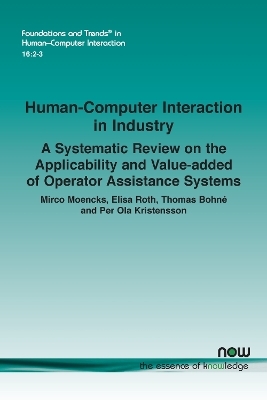
Human-Computer Interaction in Industry
A Systematic Review on the Applicability and Value-added of Operator Assistance Systems
Seiten
2022
now publishers Inc (Verlag)
978-1-63828-122-1 (ISBN)
now publishers Inc (Verlag)
978-1-63828-122-1 (ISBN)
Addresses the challenges in Operator Assistance Systems (OAS) by presenting a systematic literature review revealing 11 application areas for OAS and 12 approaches for assessing the value-added of OAS. The authors also discuss implications for OAS, with a particular focus on integration in industry.
We live in a manufactured world and the manufacturing and production industry is one of the primary sources of economic prosperity for most countries. Industries strive to produce the right goods for the right customer at the right time, location, quantity, quality, and cost. In addition to this overarching objective, they are faced with a set of challenges such as meeting increased customer requirements, increasing complexity of products and supply chains, ensuring machine and workforce productivity, and empowering the workforce by creating opportunities for training and lifelong learning. To meet these challenges organizations have leveraged technologies in production systems since the beginning of industrialization. In the 1960s, two approaches to improve production emerged: automation and augmentation. Until recently, physical and mechanical automation dominated industrial research. However, with the emergence of the Fourth Industrial Revolution, the potential of Human-Computer Interaction (HCI) serving a transformative role in manufacturing has gained significant interest and relevance in industry. Where full automation is ineffective or infeasible, Operator Assistance Systems (OAS) can augment workers’ cognitive or physical capabilities. In this monograph, the authors frame OAS as a subset of HCI systems designed for the purpose of workforce augmentation in production systems. However, while OAS are anticipated to address key needs in industry, a challenge for both OAS researchers and industrial practitioners is to identify the most promising applications of OAS and justify them from a value-added perspective. This monograph addresses the challenges in OAS by presenting a systematic literature review revealing 11 application areas for OAS and 12 approaches for assessing the value-added of OAS. The authors also discuss implications for OAS, with a particular focus on integration in industry.
We live in a manufactured world and the manufacturing and production industry is one of the primary sources of economic prosperity for most countries. Industries strive to produce the right goods for the right customer at the right time, location, quantity, quality, and cost. In addition to this overarching objective, they are faced with a set of challenges such as meeting increased customer requirements, increasing complexity of products and supply chains, ensuring machine and workforce productivity, and empowering the workforce by creating opportunities for training and lifelong learning. To meet these challenges organizations have leveraged technologies in production systems since the beginning of industrialization. In the 1960s, two approaches to improve production emerged: automation and augmentation. Until recently, physical and mechanical automation dominated industrial research. However, with the emergence of the Fourth Industrial Revolution, the potential of Human-Computer Interaction (HCI) serving a transformative role in manufacturing has gained significant interest and relevance in industry. Where full automation is ineffective or infeasible, Operator Assistance Systems (OAS) can augment workers’ cognitive or physical capabilities. In this monograph, the authors frame OAS as a subset of HCI systems designed for the purpose of workforce augmentation in production systems. However, while OAS are anticipated to address key needs in industry, a challenge for both OAS researchers and industrial practitioners is to identify the most promising applications of OAS and justify them from a value-added perspective. This monograph addresses the challenges in OAS by presenting a systematic literature review revealing 11 application areas for OAS and 12 approaches for assessing the value-added of OAS. The authors also discuss implications for OAS, with a particular focus on integration in industry.
1. Introduction
2. Systematic Review
3. Value-added of OAS
4. Application Areas of OAS
5. OAS Assessment
6. Discussion
7. Conclusions
Appendix
References
| Erscheinungsdatum | 21.11.2022 |
|---|---|
| Reihe/Serie | Foundations and Trends® in Human-Computer Interaction |
| Verlagsort | Hanover |
| Sprache | englisch |
| Maße | 156 x 234 mm |
| Gewicht | 238 g |
| Themenwelt | Informatik ► Software Entwicklung ► User Interfaces (HCI) |
| ISBN-10 | 1-63828-122-X / 163828122X |
| ISBN-13 | 978-1-63828-122-1 / 9781638281221 |
| Zustand | Neuware |
| Haben Sie eine Frage zum Produkt? |
Mehr entdecken
aus dem Bereich
aus dem Bereich
Aus- und Weiterbildung nach iSAQB-Standard zum Certified Professional …
Buch | Hardcover (2023)
dpunkt Verlag
34,90 €
Lean UX und Design Thinking: Teambasierte Entwicklung …
Buch | Hardcover (2022)
dpunkt (Verlag)
34,90 €
Wissensverarbeitung - Neuronale Netze
Buch | Hardcover (2023)
Carl Hanser (Verlag)
34,99 €


